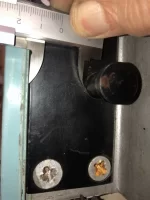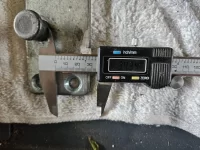My '76 Royale has a door that is somewhat hard to convince to reach the second latch.. A few years ago I found it didn't reach the second latch at all because the bottom of the door hit first, so I recurved it (2x4 in opening and PUSH). I also elongated the latch bolt holes on the door to help the second latch engage. The coach suffers from Middle Age Spread (1/2" or so at the latch, based on the cabinetry).
At the Cascaders' Rolling Rally this September I jealously watched a few folks give their doors a slight push and close with no drama, so i thought I'd look at again and consider moving the strike plate outward (and moving the latch back to its origional position on the door). Applied sells a replacement strike that, I believe, moves the strike pin 1/8" outward.
But here's the question.... if middle age spread moves the strike plate/pin outward, why did I have to move the latch inward (or pin outward) to reach the second position? Is there something else going on with the hinge, or door, or other sidewall movement that would cause that? It's possible that a PO recurved the door at some point, since the cabinet/coach gap has been there since we purchased the coach, but that should have put more curve into the door
At the Cascaders' Rolling Rally this September I jealously watched a few folks give their doors a slight push and close with no drama, so i thought I'd look at again and consider moving the strike plate outward (and moving the latch back to its origional position on the door). Applied sells a replacement strike that, I believe, moves the strike pin 1/8" outward.
But here's the question.... if middle age spread moves the strike plate/pin outward, why did I have to move the latch inward (or pin outward) to reach the second position? Is there something else going on with the hinge, or door, or other sidewall movement that would cause that? It's possible that a PO recurved the door at some point, since the cabinet/coach gap has been there since we purchased the coach, but that should have put more curve into the door





